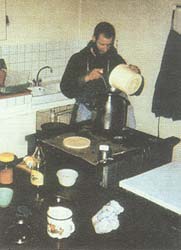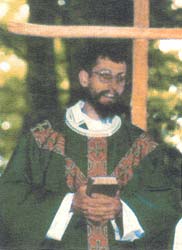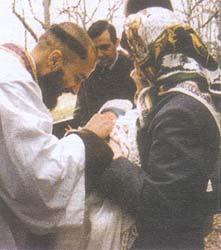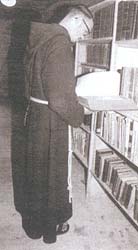THE CAPUCHINS' NEW NOVITIATE IN GASCONY:
Why was there a need for a second Capuchin monastery?
Our community, founded more than 30 years ago by the Rev. Fr. Eugene de Villeurbanne, has grown slowly but surely, and the present buildings at Morgon (Department of the Rhone) cannot accommodate more than 20 friars. Moreover, the number of priests having increased from four to eight since the year 2000, we were in a position to envisage a new foundation without detriment to our religious life and ministry.
How many of you will there be at the new foundation?
That will depend on the number of postulants and the perseverance of their vocations, because this convent is going to be a novitiate. In principle, there will be a "permanent crew" of two Fathers and one professed Brother, and the variable number of novices and postulants that Providence shall wish to entrust to us. At present, the first part of 2005, there are seven in the novitiate at Morgon, and other young people have expressed interest in our Franciscan ideal.
Our venerated Fr. Eugene had taught us, from his Capuchin experience, that when our predecessors wanted to found a monastery elsewhere, they made sure that they would find enough benefactors to facilitate their undertaking. Indeed, we are a mendicant order, living from the charity of the faithful. The people of Gers invited us repeatedly to found something there, as they had already given several vocations to Tradition (among whom is counted our Superior, Rev. Fr. Anthony de Fleurance), and still have to drive long distances to be able to assist at Mass on Sundays. They offered us an abandoned stone farm house with a little interior courtyard reminiscent of a cloister. The offer seemed providential to us, and we gladly accepted these walls within which St. Francis would not have blushed to invite Lady Poverty. Fr. Roch said at the time: "It is as beautiful as it is in ruins."
 |
 |
Where are you located?
In the north of the Gers Department, near Highway N21 which links Agen to Tarbes, between Fleurance and Lectoure, a hot springs and way station on the route to St. James of Compostella. We are also an hour and a half by road from Lourdes. A train stop is just about a mile from the convent, and puts us about five hours from Paris on the TGV. The hamlet of Aurenque counts but a few houses, enabling us to profit from the peaceful silence of the countryside, so propitious to the recollected atmosphere of a novitiate. Thus we have the advantages of the country, and also those of the city, being situated a few miles from Fleurance, where we can procure necessities and construction materials.
Are your renovations fairly extensive?
Yes, since this old farm had been abandoned for 40 years (a symbolic coincidence: since the years of the Council). The roof had caved in and trees were sprouting up in the rubble. It has been necessary to re-do everything from top to bottom. The first major work began during the summer of 2002, and we were greatly assisted by the loan of a truck nicknamed Calypso and a Caterpillar tractor. Fr. Pivert and his St. John Bosco Society boys came to lend a hand. Other volunteers came, too, from all over France in relays to help the small detachment of Capuchins on site, thus enabling a substantial part of the work to be done without excessive expenditures.
How do things stand now?
Following the principle of "God served first," we organized the operations in two stages: the first, now completed, included the chapel and the monks' choir; the second, the conventual rooms of the monastery. We had to face other priorities: repairing the roofs, installing a parking lot, the monks' cells and guests' lodging, as well as a plumbing system.
Currently, we have completed the library and have made much progress on the refectory, kitchen, laundry and the bathrooms on the first floor. Now [at the time of this interview–Ed.] months away from the scheduled inauguration, we have yet to start on the walls and ceilings of the ten remaining cells, the bathrooms on the second floor, laying tile, and whitewashing the walls.
 |
 |
Do you think that everything will be ready for the inauguration?
It will have to be, at least in essentials, since September 17th has been scheduled for the arrival of Bishop de Galarreta. As for final touches and other projects, we shall continue working with the help of the novices and, of course, any volunteers that might show up. A few less urgent projects remain, which can be postponed without detriment to the good order of the novitiate: the furnishing of a guest house, the cellar, and a workshop–all things that can be done in God's good time.
You seem to attribute quite a lot to Providence!
Yes, not to forget our good St. Anthony. From the start, following the example of Padre Pio and his great hospital, we have established the rule not to borrow. And, despite the inevitable trials and tribulations, sometimes even thanks to them, help in the form of workers, material or money has always arrived in the nick of time, like the check that was sent as a thanksgiving to St. Philomena, which reached us just as we were about to be overdrawn at the bank.
Divine Providence makes use of men, and we must thank all those priests, monks and nuns who offered us all the furnishings for the chapel and the choir; the benefactors who procured for us windows, benches, statues, and so many other welcome things that it would be too lengthy to list; and our neighbors who out of sympathy gave us a little tractor, trees to plant, and tons of building stone.
Have you any other material needs?
Yes, for example, small tables for the cells, appliances for an institutional kitchen (fridge, stove, oven). We also need to acquire a sufficient library for the novitiate. Besides works on sacred Scripture, spirituality and lives of saints, we are looking for doctrinal works: writings of the Popes, the Fathers and Doctors, theologians, as well as certain collections: dictionaries of theology and spirituality, the Ami du Clergé. We are also interested in conferences on tape.
What would you like to say in conclusion to the faithful of Tradition?
First of all, I would like to thank once again one and all who have helped us or will help us in this beautiful undertaking at Aurenque, whether by their prayers and sacrifices, by their time or their alms. "Amen I say to you, as long as you did it to one of these my least brethren, you did it to me" (Mt. 25:40). May all these benefactions made with the spirit of faith be repaid to them a hundred fold, that is, in the choicest supernatural graces.
Then, I would like to remind them that the construction site of Aurenque, even if it should last several more years, will eventually be finished; may they then persevere in their prayers for our religious vocations, for the decadent society in which we live, the pleasures of modern life, and the liberal spirit are all-pervasive, and constitute so many obstacles that impede souls chosen by the good God from consecrating themselves to His service or from persevering unto death in this ideal of love united to sacrifice, in a life that is humble, poor, and chaste.
Let us not restore only chapels, priories, and convents, but let us restore all things in our Lord Jesus Christ.
